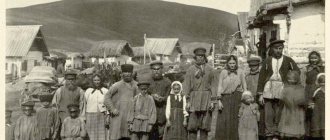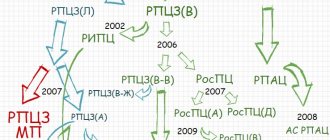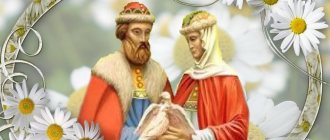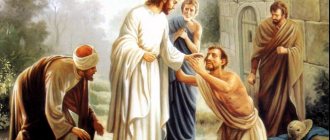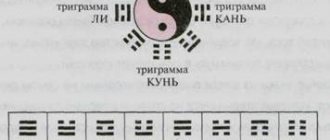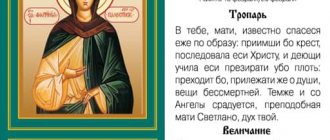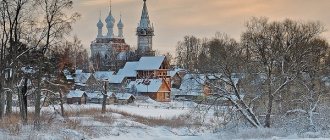Non-covetous people are followers of the religious and philosophical movement in Medieval Rus'. The founder of the ideology was Nil Sorsky. His teaching was continued by Artemy Troitsky, Maxim the Greek and Vassian Kosoy. The movement existed from the middle of the 15th to the middle of the 16th century. They got their name because they preached the ideas of “non-covetousness.” The founders of the doctrine suggested that monasteries abandon any type of property, including land. They called for the transformation of monasteries into institutions professing a purely spiritual life.
The essence of the ideology of the movement
The essence of the economic views of non-possessors boiled down to the following:
- The main changes occur in the soul, and not in the external world. The life of the spirit is true, only it corresponds to human nature.
- The spiritual development of a person requires freedom from the outside world, including material goods and values. At the same time, non-acquisitive people did not call for the other extreme - hermitism, considering it unnecessary.
- An important condition is that the outside world should not interfere with a person’s internal spiritual development.
- According to the ideologists of the doctrine, churches and monasteries should not acquire property and land plots. This contradicts the ideals of Orthodox religious morality and undermines the authority of the Church.
- Non-possessors were critical of church literature. In their letters they repeatedly called the monastic books false.
Non-covetousness is an evangelical virtue, as well as one of the monastic vows upon tonsure
In Orthodoxy we often hear such a word as “non-covetousness.” What it is? Non-covetousness is an evangelical virtue, which is expressed in a person’s independence from the passion for hoarding, as well as excessive attachment to material goods. It is the subject of one of the three monastic vows that is considered to be non-covetousness. Let's consider what the holy fathers said about what non-covetousness is and how to acquire it.
The Monk Isaac the Syrian said that no one can acquire true non-covetousness if he cannot endure all temptations with great joy in his soul:
“...no one can acquire real non-covetousness unless he prepares to endure temptations with joy. Without non-acquisitiveness, the soul cannot free itself from the rebellion of thoughts and, without bringing the feelings into silence, it will not feel peace in thought.”
Isaac Sirina
Reverend
[/aside]
Saint Ignatius Brianchaninov said that in order to acquire love for spiritual and heavenly objects, one must completely renounce love for earthly objects:
“...He who distributed his property to the poor in order to show complete obedience to the Savior... who himself became a beggar in order to subject himself to the hardships associated with poverty and abundantly bringing humility, by this action destroys all his hope in the world, concentrating it in God.
In order to acquire love for spiritual and heavenly objects, one must renounce love for earthly objects. Non-acquisitiveness and renunciation of the world are a necessary condition for achieving perfection. The mind and heart must be completely directed towards God, all obstacles, all reasons for entertainment must be eliminated...”
Ignatiy Brianchaninov
saint
[/aside]
History of development
The idea of non-covetousness was born and formed in the Kirillo-Belozersky Monastery. The first disagreements arose under Abbot Tryphon. They concerned the acquisition of monastery estates.
Subsequently, the monastery refused to acquire land and accept donations. In 1482, Abbot Serapion accepted a gift of land from Ivan III. In 1483, 15 monks left the monastery in protest. After the intervention of Prince Belozersky, Abbot Serapion was removed, and the elders returned to the monastery.
The Josephites, supporters of the views of Joseph Volotsky, became the ideological opponents of the non-covetous people.
Brief biographical information:
Joseph Volotsky (1439–1515) – abbot of the Joseph-Volokolamsk Monastery. Famous church leader, philosopher and writer. The son of a Volokolamsk boyar, he took monastic vows in his youth. He led an ascetic lifestyle. He established strict rules in his monastery. He acted as an apologist for state power and church dogma, and fought against heresy. He considered active social activity and helping people to be the ideal of monastic life. He led the movement of the Josephites and entered into an ideological struggle with non-covetous people. In 1579 he was canonized and canonized.
Confrontation
Joseph advocated that the king fulfills a divine purpose, although he remains an ordinary person. Volotsky believed that the tsar must be obeyed, but since the tsar is subject only to the body, and not the soul, then people should be given royal honor.
However, Joseph Volotsky argued that the king is far from the first person in the state and all spiritual power is in the hands of the church, which is why the church must be worshiped more than the ruler.
Thus, the Josephites advocated that not all power is “from God,” but there is also power “from the devil,” however, after Ivan III took the side of the Josephite clergy, Volotsky radically changed his opinion to the opposite. The Josephites began to adhere to the idea that the king is responsible for his subjects before God, so he must take care of them and protect them in every possible way, not only physically, but also spiritually. That is why Joseph’s followers began to actively protect the faith and persecute heretics, whom they considered robbers who negatively influenced human souls.
In turn, non-possessors tried in every possible way to intercede for the heretics. It follows from this that the state could invade spiritual life, since the king is the messenger of God and does everything that the Almighty requires. Disobedience to the ruler was now considered not only a crime, but also a great sin. In one of his letters, Joseph called on people to serve the king as the Lord.
That is why the authorities were very interested in the ideology of the Josephites, because for one and the other side it was a very profitable deal. Moscow rulers could become inaccessible to society, leaving the church with privileges in the form of land holdings, and the church, in turn, was ready to completely submit to the state.
The struggle between these two directions continued for several more decades, and everything led to the fact that the Josephite ideology won. However, everything led to the fact that the tsar robbed many churches, forced the clergy to deprive Metropolitan Philip of his rank, and later Philip was completely strangled by order of the tsar.
Cathedral 1503
In 1503, a Council of the Russian Orthodox Church was convened. During the meetings, a dispute arose about the monastery property. Most likely, the issue was raised by Ivan III. The Grand Duke was interested in the alienation of monastery lands. The views of the Trans-Volga monks contributed to his goals. Nil Sorsky came up with the idea of limiting church lands.
The opponents were the Archbishop of Novgorod and Abbot Serapion. The church hierarchs won the dispute, and the issue was postponed for some time.
Spiritual leaders
| Name | Years of life | short biography |
| Venerable Neil of Sorsky | 1433–1508 | In his youth, he took monastic vows at the Kirillo-Belozersky Monastery. Traveled a lot, lived in the Athos monastery. Upon his return, he became a hermit and founded the Nilova Hermitage. He spoke a lot with the ideas of non-covetousness, orally and in writing. |
| Vassian Patrikeev (in the world V.P. Patrikeev) | 1470–1545 | Prince from the Gedimina family. He was in the civil service and was a governor. Accused of high treason, he took monastic vows at the Kirillo-Belozersky Monastery. Became a follower of the teachings of Nil Sorsky. He sharply criticized the ideas of Joseph Volotsky. |
| Maxim Grek (Mikhail Trivolis) | 1470–1556 | Comes from a noble Greek family. Received an excellent education in Europe. In 1518 he arrived in Moscow. I met Vassian Paatrikeev. He shared and actively preached his views. |
Joseph Volotsky and Nil Sorsky
This article is a preface to the book of the same name, published in May 2011. The book touches on one of the most popular and painful topics in the history of Russian holiness - the dispute between the Trans-Volga non-covetous elders and the followers of St. Joseph, who cared about monastic landholdings. The proposed article only gives an indication of the stated topic, so we suggest that everyone interested in this issue read the book itself.
The Venerable Joseph of Volotsk and the Venerable Nil of Sora, “Josephites” and “non-covetous”, is a topic that occupies minds from the 16th century to the present day.
During the lives of the saints, such a contrast was necessary for the rulers of Muscovite Rus' themselves. The rapid growth of monastic land ownership worried the grand ducal authorities, who were in dire need of free lands to distribute to service people. And here, for her, much more profitable was the preaching of the non-covetous Trans-Volga residents, who said that “there should be no villages near the monasteries, but that the monks should live in the deserts and feed themselves on handicrafts” in complete renunciation from the world. However, for St. Joseph the inseparability of the Church and the state was completely obvious, when a cultural, literate Church is an assistant to the Christian state. There should be no bifurcation of the spiritual and material sides, but a “symphonic” agreement, prescribed by the IV Ecumenical Council, is necessary. He thought of state prosperity as an ideal and norm, in unity with an enlightened church hierarchy.
But a little time passed, and these views of the Monk Joseph were declared self-serving and erroneous. For the dominant anti-religious majority, it was beneficial to support what would break the connection between the Church and everything worldly. This is where the exaltation of the “pure evangelical Christianity” of St. Nilus of Sora arose.
This topic became even more popular in the second half of the 19th century, when the course towards the destruction of Orthodoxy became quite clear. It was then that the idea of the Rev. was formulated and consolidated. Joseph Volotsky and his followers, the “Josephites”, as conservatives and formalists, and about Rev. Nile Sorsky and his followers, “non-acquisitive”, as liberals of a critical-moral direction (V.I. Zhmakin and others).
The twentieth century, a godless and godless time, having erased the names of the people of the Church from textbooks, could not destroy interest in outstanding figures of the Middle Ages. However, even for serious academic researchers in an environment of atheistic propaganda, it was impossible to maintain objectivity: everything related to church history had to be presented with a “minus” sign.
As a result of such a politicized, opportunistic approach, the images of two great saints, the brightest stars of Russian Orthodoxy, turned out to be clouded and distorted, sometimes beyond recognition.
A new surge of interest in this topic is already happening in our time. In many publications we come across these familiar names. Moreover, if we are talking about one saint, then a few lines later, as a contrast that has already become obligatory, the second one is mentioned.
However, labels from a century and a half ago are now used for slightly different purposes. People abandoned centuries-old atheism and again accepted Orthodoxy into the sphere of their “vital interests.” Only “suddenly” it turned out that it in no way fits into our idea that we need to live, as they say now, “comfortably,” happily and carefree. And here the Orthodox faith turned out to be very inconvenient and even difficult. Is it possible to somehow adapt it to our way of life so that it is not so burdensome?
But here we are faced with bitter disappointment. It is enough to open the Gospel to understand the futility of these attempts. Everywhere there is only: “leave everything, take up your cross and follow Me” (see: Matt. 10:38; 16:24; 19:21; Mark 8:34; 10:21; Luke 9:23; 14 ,27, 18,22).
And here the same church-related writers, now of a new generation, come to the rescue. It turns out, in their opinion, we don’t need to strictly adhere to the “conservative” views of St. Joseph of Volotsky, when we have an equally great, but more “convenient” elder - the critically minded “liberal” St. Nil of Sorsky, who seems to allow us to slightly rebuild Orthodoxy to your liking.
But is this really the case? Let us at least think about the fact that usually the reformers immediately came to deny monasticism, got married and lived quite freely, no longer binding themselves to any strictness. And the life of Rev. Nile of Sorsky - from entry into monasticism until his death - this is a complete renunciation of all worldly goods, in his own expression, “the cruelty of a narrow and regrettable path.” In addition, the goal of the reformers is to abolish the church hierarchy, but the Monk Neil never strived for power and recognized the decisions of councils and bishops, unconditionally submitting to them, without insisting on his opinion, and especially without going into schism. The reformers always asserted their position on the words of Holy Scripture interpreted in their own interests or taken out of context, however, in the writings of St. Nile of Sora did not find a single phrase that would reinterpret the Word of God and would be a deviation from the teaching of the Holy Fathers. No, it’s impossible to detect a liberal in him, no matter how you look at it. No freedom (liberalis - Latin, “free”), but only the already well-known shackles of faith with which the Monk Nile voluntarily and tightly bound himself.
It turns out that the “liberal” St. Nil Sorsky was no different from his contemporary “conservative” - the abbot of one of the richest monasteries in Rus' - St. Joseph Volotsky, whose biographies testify to the same thing: meager food, thin clothing, hard physical labor, wearing chains. Both of them were elders, both were engaged in literary works. Moreover, Rev. Nil Sorsky highly respected the works of St. Joseph of Volotsky, and in the Volokolamsk monastery the monks carefully studied the writings of the Sorsk ascetic. It would not be amiss to mention that the scant information we have about the life of St. Neil became known largely thanks to the 16th-century manuscript of the Archimandrite of the Volokolamsk Monastery, who copied into his collection a letter from an unknown person about St. Neil Sorsk.
The Monk Nil was raised in the Kirillo-Belozersky Monastery, and the Monk Joseph lived for some time in this famous monastery, the charter of which he took as a model for his monastery.
We will find the difference in the structure of their own monasteries.
Here it is necessary to clarify that traditionally monastic life is divided into three types: the first - when many monks live and labor together (the founder of cenobitic monasteries is considered to be St. Pachomius the Great), the second type - hermitage, when the monk lives in complete solitude (the founder of such a life is St. Anthony Great), the third type is wandering, when a monk labors together with two or three other monks (this type traditionally flourished on Athos).
Rev. Nil Sorsky built his monastery according to the monastery principle. He considered this type of residence to be an average between the first two and called it royal. There were only 12 monks here, they lived quite separately. The Monk Neil received only spiritually experienced monks. The main subject and concern of the hermits was supposed to be “smart doing,” which Rev. Nile studied and observed on Mount Athos.
Monastery of St. Joseph Volotsky was founded on the principles of community life: everything is common - work, prayer, meals. There were many brethren; anyone who wanted to take the path of monasticism could come here. In both monasteries the principle of complete non-covetousness was proclaimed. At the same time, the Volokolamsk monastery was a large landowner, and the Sorsk hermitage had neither land nor peasants.
It is traditionally believed that the venerable Nil of Sorsky and Joseph of Volotsky argued over the land ownership of the monasteries. However, during the life of Rev. Nile of Sorsky until 1508, they both write nothing on this issue. There is no reliable evidence of their speech at the council of 1503. It is usually customary to use the famous “Letter about the disliked monks of the Kirill and Joseph monasteries” as a source. But this letter was written by an unknown person already in the 40s of the 16th century and the content is far from perfect. For example, among the participants of the cathedral the author names the teacher Rev. Nile of Sorsky - Elder Paisius Yaroslavov, who had already died by that time. And the often quoted speech of St. Joseph at the council - “If there are no villages near the monasteries, how can an honest and noble man take monastic vows?..” - does not find confirmation in his own messages. There is not even a hint of the argumentation attributed to the monk. Moreover, the enemy Rev. Joseph of Volotsk Vassian Patrikeev generally does not know the speech of the Volotsk abbot at the cathedral. It is difficult to imagine that he would not have criticized the words of the Monk Joseph if they had actually been spoken.
But even if there was confrontation at the council, could the Rev. Is Nil Sorsky such an ardent opponent of monastic estates? Hardly. He understood perfectly well that if acquisitiveness is not exterminated as a personal passion, as the passion of love of money, then it can exist, as St. John Cassian, “and in extreme visible poverty.” That is, the presence or absence of rich estates at the monastery, in principle, does not in any way affect the observance of the vow of non-covetousness by each individual monk.
In addition, the Monk Neil, as an educated and thoughtful person, could not help but know what role monastic land ownership played both in Rus' and in Greece, where he lived for several years on Holy Mount Athos. The situation was similar. Rus' was under the rule of the Mongol-Tatars, and Greece was under the yoke of the Turks. So, those lands that the monasteries owned were protected from the arbitrariness of the “occupation” authorities. In Rus', due to the khan's privileges and the charters of the princes, church lands did not pay state duties and were exempt from paying tribute to the Tatars, which allowed the peasants to survive under conditions of severe yoke. The ancient Svyatogorsk monks did not stop buying land during the period of Turkish rule, and the territory that belonged to them retained its absolute Hellenization. Greeks came here from different places, seeking salvation from cruel slavery. In addition, the monasteries of the Holy Mountain received land holdings from emperors and princes. And they protected these lands from Turkish violence, making rich offerings to the Turkish sultans. For centuries, Turkish firmans were kept in the archives of Athonite monasteries, protecting them from any oppression. Thus, the peasants who inhabited the monastery estates received protection and assistance, in turn, providing the monks with the necessary income. In addition, monastic land ownership was economically profitable, since the monks themselves did not receive any payment for their work.
To this we can add that in his desert, St. Nil Sorsky failed to implement the lofty principle he declared - to feed only by the labor of his own hands. Having forbidden the brethren to even accept alms, he was finally forced to turn to Grand Duke Vasily Ioannovich for help. Every year the monks received 155 quarters of rye flour from the prince. Moreover, the “non-covetous” suggested that all monasteries follow this path. Life has shown the absolute utopianism of these plans: Catherine II, having carried out secularization, i.e. having confiscated land from the Church, she simply closed the bulk of the monasteries.
After the death of Rev. Nile of Sorsky, his place in the positions of non-covetousness was taken by Vassian Patrikeev (c. 1470 - after 1531), who can only be called a disciple of the Monk Nile, and indeed a monk in general, only with a great stretch. He took monastic vows in order to save his life; he practically did not live in the monastery, but had his own “desert on Beloozero,” from where he soon moved to Moscow. In Moscow, while in the Simonov Monastery, he led a fairly free life, received food and wine from the table of the Grand Duke, disdaining the monastic meal. In complete contradiction with the regulations, he ate and drank when he wanted and what he wanted.
Vassian became a confidant of Grand Duke Vasily III. He was of noble origin, a relative of the prince. Before his forced tonsure, Prince Vasily Patrikeev was a prominent figure in the state and one of the richest landowners, but now, being a monk, Vassian no longer posed any danger in the political sphere for the Moscow prince. The clerk Mikhail Medovartsev speaks about his role at court: “And you, sir, were hesitant to listen to the elder Prince Vasyan, because he was a great temporary man, the Grand Duke’s neighbor and the tongue did not vomit the sovereign, as he vomited and listened to him.”
Vassian Patrikeev gained his fame in history, including in the history of literature, with his writings against St. Joseph Volotsky and his followers - “Josephites”. Moreover, Vassian did not possess special talents and gifts, and if the personality of the reverend had not been so famous and significant. Joseph Volotsky, it is unlikely that we would have known “the outstanding Russian publicist of the 16th century” (“Literature of Ancient Rus'.” Bio-bibliographic dictionary). By attacking the Monk Joseph, Vassian, on the one hand, wanted to please the Grand Duke, who urgently needed lands to distribute as estates, and on the other hand, he sought to weaken the influence of the hegumen on the Prince of Volotsk, whose high authority prevented Vassian from exercising sole power at court.
The works of Vassian Patrikeev are usually called polemical. However, there was no controversy. The Grand Duke simply forbade the Monk Joseph to answer Vassian both orally and in writing, to which the Monk completely obeyed. Thus, “The Debate with Joseph Volotsky,” written by Vassian Patrikeev in the form of a dialogue, cannot be considered a document indicating a polemic between the leaders of the two parties. At the same time, Vassian’s writings are distinguished by sharpness and passion; his speech shows pride and contempt, which once again shows how far he was from monastic and Christian ideals in general and from the views of his teacher in particular. Only high patronage protected the prince from exile under strict supervision with the wording “for restless pride and quarrelsomeness, unusual for the monastic rank, for low means and unsubstantiated claims.”
The same can be said about another ardent hater of the “Josephites” - Prince Andrei Kurbsky (1528-1583), who fled to Lithuania and became famous for his tales, which contain more lies than truth. He called himself a student of another famous representative of the “non-covetous” party - Rev. Maxim Grek (+1555). Having entered the service of the Lithuanian prince, Kurbsky received large land holdings along with the Kovel Castle, as if completely forgetting that poverty is a common Christian ideal. Although this is not surprising. For some reason, we do not personally apply to ourselves the words of Christ, spoken not only to the apostles, but to the people: “For anyone of you who does not renounce all that he has cannot be my disciple” (Luke 14:33). As Hieromartyr Hilarion of the Trinity correctly noted already in the twentieth century: “We have a very widespread prejudice among the laity that asceticism is the specialty of monks.” Let's add - there is and was.
The following example testifies to the historical objectivity of Prince Kurbsky: in terms of the severity of his life, he compared Vassian Patrikeev no more and no less than the Venerable. Anthony the Great and St. John the Baptist. Comments, as they say, are unnecessary.
The next contrast between the two great saints, which arose relatively recently, concerns the monastic rules. Nowadays it is customary to admire the Rule of St. Neil as highly spiritual, and to disparage the Rule of St. Joseph as mundane, “everyday.” In defense of the Charter, Rev. Joseph of Volotsky can cite a phrase written back in the 6th century by the Venerable. Benedict of Nursia: “We wrote this Charter so that those who observe it can achieve purity of morals or show the beginnings of Christian prosperity. For those who wish to ascend to the highest degrees of perfection, there are instructions from the Holy Fathers.” It was in this spirit that the Rev. wrote his Charter. Joseph Volotsky is the abbot of a large communal monastery. The Rule instructed in external monasticism, and for internal improvement, each one used the advice of his elder, was guided by the lives of the ancient ascetics and the patristic writings, which were constantly read in church, at meals, and in cells. The monastery library had a rich collection of books, and therefore St. Joseph did not need to rewrite the teachings of the great teachers of monasticism in his Rules.
Charter Rev. Nile of Sorsky is a guide for hermits who have tested themselves in a monastery, established themselves in spiritual life and retired to the desert in search of silence and solitude. On the one hand, they no longer need detailed instructions regarding external lifestyle and behavior, although they are also present in the Charter. On the other hand, books may not always be available to a monk, and communication with an elder is limited, so the Monk Neil consistently outlined all the stages of internal self-improvement in strict accordance with the teachings of the Holy Fathers. Rev. Neil did not reject the importance of the external work of monks, but, first of all, he wanted to remind them that they cannot limit themselves to this, that internal asceticism is very important and essential, which must be combined with external ones.
But generally speaking, is “external” monasticism so important, and is it necessary? It turns out yes. Let us trust the experience of St. Basil the Great, who asserted: “If the outer man is not well-ordered, do not trust the well-being of the inner man.”
Thus, none of these charters had any advantages over the other. They were created in relation to different living conditions in the monastery, addressed to people who have completely different monastic experience, do not contradict each other in any way and may well complement one another. And, of course, it is a big mistake on the part of the researcher or reader to try to draw conclusions about the level of spiritual life in any monastery based only on the charter.
As for the very way of monastic life, the advantage here is on the side of cenobitic monasteries. As noted by Rev. Benedict of Nursia: “The Cenobites, living in one monastery according to a common charter, are the most trustworthy kind of monasticism.” Not everyone chooses to live in the desert as an intensified feat after a long stay in a cenobitic monastery. It happens that desert people are attracted by the absence of any control and the opportunity to live according to their own will, although sometimes it seems that this will agrees with the will of God. The Holy Fathers allow only a monk who has completely cleansed himself of passions to go into the desert, and few people have succeeded and succeed in this. In the history of Russian monasticism, living in the desert has remained a rare and exceptional feat.
Another contrast between the positions of Rev. Nil Sorsky and Rev. Joseph Volotsky, invented by educated but not enlightened minds, is the attitude towards the “scriptures”.
From book to book, from author to author, a phrase from the letter of the Rev. migrates. Nila Sorsky: “There is a lot of Scripture, but not all of it is divine. But you, having experienced the true knowledge from reading, hold fast to these,” which is interpreted as a call for a critical analysis of all scriptures. Here, first of all, we must once again recall that nowhere, not in a single line, did the Monk Nile himself deviate from the patristic interpretation of the Holy Scriptures and Holy Tradition. Could he teach this to others? Of course not.
He was very strict in relation to the content of texts, if it happened that as a result of rewriting or attempts to modernize old texts lost their meaning. For example, when compiling his “Collection of Lives of Greek Saints,” the Monk Neil gave preference to more ancient, classical examples of lives. He sought to achieve the greatest clarity of the meaning of the story, for which he compared different lists, choosing the most understandable expressions. But if he still could not find a text that would suit him, he left a blank space in his manuscript, not daring to write something according to his own understanding: “but what is impossible, I left this, so that those who have more understanding than us will correct it uncorrected, and what is insufficient will be filled.”
The “Cathedral Book” of the Monk Nile was for a long time considered not to have survived, but it was discovered among the books of the library of the Volokolamsk Monastery. Two volumes of the Sobornik - autograph of Rev. Nile of Sorsky - were supplemented by the monks of the monastery with words and teachings about non-covetousness, reinforcing the views of the Monk Nile. Let us add: and the views of Rev. Joseph Volotsky.
One should also take into account the fact that, along with the lives of saints, the so-called apocrypha, created on themes from the Holy Scriptures, were in circulation at all times, but the content of which was often so far from the divine that it was necessary to prohibit them, since they generated (and in our days this also happens) all kinds of heresies and sects. In addition, there were cases when an unknown monk signed his own work of faulty content with the name of one of the Holy Fathers. Most likely, Rev. Neil Sorsky warned his correspondent about being careful with this kind of writing.
The very concept of “testing the scriptures” has also been misinterpreted. The Monk Neil writes about himself: “Living in solitude, I test the Divine Scriptures, according to the commandment of the Lord, and their interpretation, as well as the Apostolic traditions, lives and teachings of St. Fathers and I listen to them.” The word “test” in this case means “to study, to learn.” In general, in the Church Slavonic language it does not have the connotation that is given to it in the Russian language “to be convinced by research, to try, to analyze,” and even more so “to question or critically comprehend.”
Here the position of the Holy Fathers is completely definite and unshakable. This is how Rev. writes. Simeon the New Theologian about this kind of “test”: “...we are commanded not to torture the dogmas of Scripture with reason... He who tests does not have firm faith.” The Holy Fathers also warn about the danger of following one’s own taste: “Let no one take or deduce anything separately from what we have said, and, putting everything else aside, let no one unreasonably hold this one thing in his hands” (St. Isaac the Syrian).
Saint Basil the Great, in his brief teaching, instructs how to study the Divine Scriptures with the following example: “... let us have the attitude towards the teaching of the Lord that is in the teaching of a child, who does not contradict, does not justify himself before the teachers, but faithfully and dutifully accepts the lessons.”
Of course, Rev. Nil of Sorsky knew all this, because his “Rule of the Life of the Skete” contains many quotes from St. Isaac the Syrian, and from St. Simeon the New Theologian, and from St. Basil the Great. Is it possible, let us ask ourselves this question, that the Monk Nilus, having decided to become a mentor of monks himself, rejected the instructions of the great teachers of monasticism? It's impossible to even imagine. After all, they warn us that deviation from the patristic teachings “leads to pride and then plunges into destruction,” and, as history shows, this is what gives rise to Protestantism and all kinds of heresies and sects.
Let’s take better other lines from the letter of the Monk Neil: “... we do not know the Divine Scripture and do not strive to study it with the fear of God and humility.” Isn’t this said about us, today, when against the backdrop of complete “religious savagery,” in the words of Elder John Krestyankin, every head has its own faith? We need these very words from Rev. To quote Nil of Sorsky more often, and most importantly, to remember and know that the “testing” of the scriptures should begin with the fear of God and humility, and not with one’s own speculations and critical moods, so as not to “be carried away in a whirlwind of harmful thoughts” (St. Simeon the New Theologian) .
On the other hand, Rev. Joseph Volotsky is often credited with the words: “A mother’s passion is opinion. Opinion is the second fall,” deducing from here, in contrast to the “free-thinking” of St. Nile of Sorsky prohibition of personal opinions of the Rev. Joseph Volotsky. However, we will not find this quote either in the “Illuminator” or in the texts of other writings authored by the Monk Joseph. This phrase ends the same “Letter about the Loveless”, and with a specific indication: “like the holy fathers of the rekosha.” And since this was said by the Holy Fathers, whose authority is unshakable, then the warning about the danger of their own opinions was equally accepted and obeyed by the venerables. Joseph Volotsky and Rev. Neil Sorsky.
Over the course of many centuries, the names of the two great saints of the Russian Church have acquired opinions, speculations, and traditions of varying degrees of reliability. Who hasn’t used and isn’t using this imaginary confrontation as an argument! It’s all the more interesting to try to figure out where the truth is and where the lies are, and at the same time find out what remains forever in the past and what needs to be preserved for the future. This is the purpose of publishing this collection. Without at all pretending to complete the picture, we have combined here articles that reflect the views of our contemporaries.
First of all, these are two prominent church hierarchs - Metropolitan Anthony of Sourozh (Bloom, 1914-2003) and Metropolitan of Volokolamsk and Yuryev Pitirim (Nechaev, 1926-2003).
Metropolitan Pitirim (Nechaev) – Doctor of Theology, Professor of the Moscow Theological Academy, for a long time headed the Publishing Department of the Moscow Patriarchate. In 1989, he became abbot of the Joseph-Volotsk Monastery, which was returned to the Church. He is known as a deep expert on the Holy Scriptures and Church history.
Metropolitan Anthony (Bloom) headed the Western European Exarchate. He grew up in exile and spent his entire life abroad. He did not have a theological education, but for his labors he received the title of honorary doctor of theology from the Moscow and Kyiv academies. Known as an outstanding preacher and wise shepherd.
Another of the authors is Vadim Valerianovich Kozhinov (1930-2001), literary critic, publicist, historian. He possessed encyclopedic knowledge, and as a scientist he was characterized by exceptional scientific integrity. His works are devoted to the problems of history and culture of the Russian people.
Vladimir Mikhailovich Kirillin, professor at the Moscow Theological Academy, is the author of many works on the history of ancient Russian literature, one of the most authoritative experts in this field. He is distinguished by a broad scientific outlook and a desire to convey to today's readers the treasures of ancient literature.
Historian, Candidate of Sciences Elena Vladimirovna Romanenko devoted herself to an in-depth, detailed study of the life and works of St. Nile Sorsky and the history of the Nilo-Sorsky desert from ancient times to the present day.
The publications of these authors always arouse interest, allowing you to take a different look at long-known facts or learn something new discovered by scientists in ancient monastic archives.
I would like to wish the readers that the main result of reading this book would be a feeling of gratitude to our great saints: one for the example of a life separated from everything worldly, the other for an example of a life where everything worldly is subordinated to the spiritual. Undoubtedly, both are very difficult and almost unrealistic, but the unattainability of the ideal does not mean that one should not strive for it.
Elena Vasilyeva, archivist of the monastery.
Opinion on heresy
At the end of the 15th century, the rationalistic sect of Judaizers began to actively operate in Novgorod. Her teaching, although considered heretical, aroused interest even in ruling circles and among the highest clergy.
Heresy is a deviation from religious norms and dogmas.
In 1504, the Church Council decided to burn heretics. This caused unrest in society, since such measures were uncharacteristic for the Orthodox Church. The disciples of Nil Sorsky were against radical measures. They proposed to fight heresy with word and persuasion. As a result, the victory remained with the supporters of Joseph Volotsky.
Opinion about monastery property
One of the main issues that caused disagreement among the monks was church and monastery property.
The opinion of supporters of Nil Sorsky boiled down to the following:
- Earthly goods are an obstacle to the development of the soul.
- Monks cannot devote enough time to prayer if they are busy cultivating the land, earning money and other worldly matters.
- A monk must independently obtain food and shelter for himself, surrendering himself to the will of God and spiritual achievement.
The Josephites were convinced that the monk’s mission was to help ordinary people. Monastic property made it possible to help the poor, build hospitals, orphanages for children, and engage in education.
Monks who come to serve in the monastery take a vow of non-covetousness
Monks who come to serve in the monastery and give their lives to God take a vow of non-covetousness. This is what is given at tonsure. A monk who trusts in the Kingdom of Heaven denies all earthly riches down to the very minimum property, because the guarantee of his safe existence is not in the abundance of supplies, but in Christ. It is in this that the monk finds real wealth.
Non-covetousness is not only moral commandments, but it is a condition for perfection, which every person should strive for. It is then that he will become a citizen of the Kingdom of Heaven.
Non-acquisitive people and the state
The ideology of non-acquisitive people also extended to the attitude towards secular power. Any ruler was seen as the embodiment of human vices.
In his essay, Maxim the Greek laments the absence of “benevolent kings.” Contemporary rulers care only about their earthly interests. In an effort to expand their possessions, they go to war against each other and shed blood.
Recognizing earthly power as vicious, non-covetous people declared Jesus Christ their only king, and the kingdom of heaven as their state.
Table
Josephites and non-possessors, a comparative table of monks is presented below.
| Criteria for comparison | Non-covetous people | Josephites |
| Thought leader | Neil Sorsky | Joseph Volotsky |
| Followers | Vassian (Patrikeev), Maxim Grek | – |
| Question about land | The church does not need land, since the church should not conduct any economic activity | The church must own lands and wealth |
| Relationships with authorities | The affairs of church and state must be separate from each other | The head of the church and the prince are equal |
| Attitude towards heretics | Opposed the execution of heretics | They advocated the execution of heretics |
| Attitudes towards property ownership | Opposed | advocated |
| Attitude to power | The government and the church do not intersect | Ready to recognize the primacy of power |
Victory of the Josephites
During the Council, the Josephites managed to defend the rights of church land ownership. They were guided by legal documents and historical cases dating back to the time of the Byzantine Emperor Constantine.
The struggle of doctrines intensified every now and then and affected various aspects of church and political life. For their harsh statements, Vassian and Maxim the Greek were betrayed and imprisoned.
Since the teaching of the Josephites was convenient and beneficial for the secular authorities, it received active support from the rulers.
"Second Wave"
The renewal of the philosophical and political dispute occurred in the 40s and 50s of the 16th century:
- The state authorities were interested in the alienation of monastic lands and again tried to find support among non-acquisitive people.
- In many ways, the political confrontation was associated with the reforms of Metropolitan Macarius.
- The ideas of the non-covetous people were supported by Archpriest Sylvester and Alexey Adashev.
At this time, non-possessors were promoted to high church positions. However, in 1554, many of them appeared before the cathedral court on charges of heresy.
Historical meaning
The political and philosophical views of non-possessors concerned not only property issues. The followers of this teaching openly expressed their attitude towards the mission of the monk, ecclesiastical and secular authorities, as well as issues of faith.
At the initial stages of development, the teaching interested secular rulers and found support from them. Subsequently, the state found itself closer to the views of the opponents of the non-covetous people - the Josephites. This led to the virtual destruction of non-acquisitiveness as a political movement.
References:
- Romanenko E.V. Nil Sorsky and the traditions of Russian monasticism. – M.: –2003
- Pliguzov A.I. Polemics in the Russian Church in the first third of the 16th century. M.: - 2002
- Kartashev A.V. Essays on the history of the Russian Church. Volume 1. M.: - 2009.
Definition
Josephites and non-covetous people are representatives of the church-political movement who advocated different ideologies.
Many aspects of the spiritual issues of those years remain relevant today. In the 15th-16th centuries, the church always took part in the fate of the country, and many events took place without the intervention of a spiritual organization.
